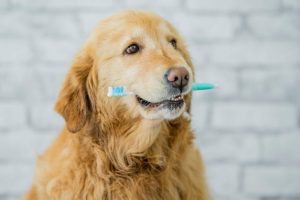Keeping Short Nosed Breeds Cool in the Heat
Time to read: 4 mins
As part of our daily routine we all clean our teeth, we wouldn’t go out without doing this in most cases and we all find bad breath offensive, so let’s work together to stop our pets having the same issues. Did you know that 80% of pets suffer from some form of gum or tooth issue due to lack of awareness of dental hygiene for pets?

Prevention is better than cure and could avoid costly dental bills at the vets
It’s a good idea to ask your vet or vet nurse to give you a demonstration of how best to clean your dog’s teeth – that way you’ll get it right from the start.
● Choose a time when your dog is naturally quiet and relaxed, then establish a routine by doing it at the same time each day.
● You can use a toothbrush specially designed for dogs, a rubber finger brush or an electric toothbrush too (if your dog will tolerate the sound). The main thing is that it is soft and appropriately sized for your dog’s mouth.
● Choose a dog toothpaste which is low foaming and free from artificial flavourings and colourings. Many pet toothpastes are enzymatic, which means that they contain enzymes to help break down the food debris that sticks to the teeth and can be swallowed. Most pet toothpastes are also meat flavoured too so that they’re better tolerated by your dog. Don’t use toothpaste for humans – these are designed to be spat out and are not good for your dog.
● To begin with, massage your dog’s gums with your finger to help them get used to the new sensation. Then gradually introduce the toothbrush. Brush gently, stroking from the gums downward.
● Start by brushing for just a minute or two a day and build up. If you make brushing a habit and follow it with a treat or reward, your dog will soon start to become used to it and even enjoy it!
Prevention is better than cure ….
Prevention is by far the best approach for helping your dog with their dental health. Start by making sure that your dog’s diet is healthy and wholesome. The next big thing is cleaning. Unless you take steps to clean their teeth every day, an invisible film of sticky plaque will build up on your dog’s teeth. This is bad because plaque will accumulate to become the hard, brown, material that we can see, which is called tartar. Tartar causes inflammation of the gums, gingivitis, and periodontal disease, which eventually leads to rotten teeth and tooth loss.
Since tartar can’t be removed by brushing it will become necessary for your dog to go to the vets for a dental hygiene check up where your vet removes it whilst your dog is under general anaesthetic. Far better, therefore, to spend a few minutes each day brushing your dog’s teeth to remove the plaque before it builds up.
In the event that your dog does require treatment, pet insurance can cover dental procedures arising from accidents and injuries.
Keeping Short Nosed Breeds Cool in the Heat
Why keeping your pet’s microchip records up to date matters
Looking after cats with arthritis